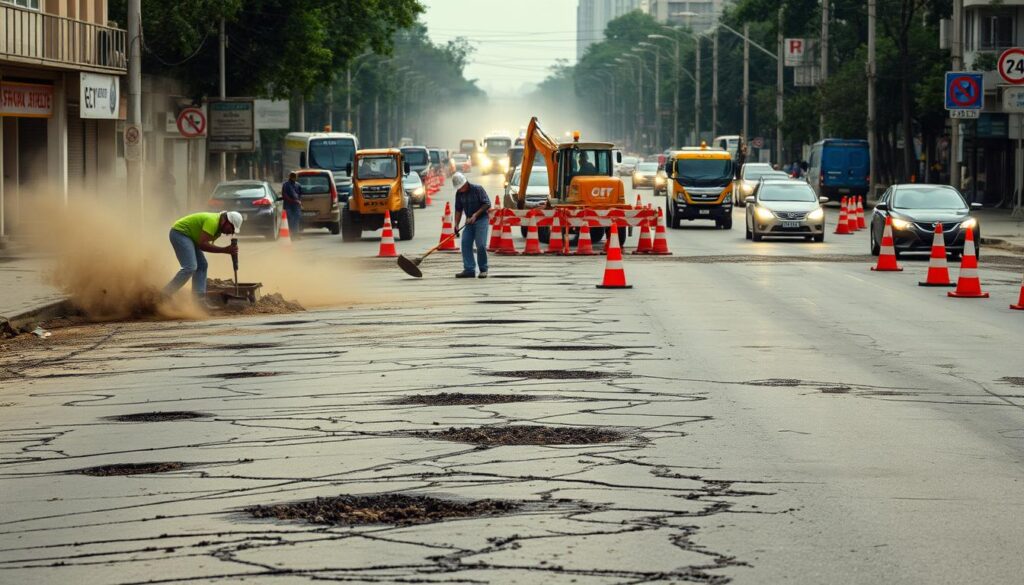Can our transportation infrastructure withstand the demands of a growing population and increasing traffic congestion? The answer lies in infrastructure improvement through effective pavement rehabilitation techniques.
The durability of our roads and highways is crucial for safe and efficient travel. Full-depth reclamation, a technique used in transportation engineering, has proven to be a cost-effective and sustainable solution for improving infrastructure durability.
By adopting innovative methods like full-depth reclamation, we can extend the lifespan of our roads, reduce maintenance costs, and enhance overall transportation efficiency.
Key Takeaways
- Effective pavement rehabilitation techniques are crucial for infrastructure durability.
- Full-depth reclamation is a cost-effective and sustainable solution.
- Transportation engineering plays a vital role in improving road infrastructure.
- Infrastructure improvement is essential for safe and efficient travel.
- Innovative methods can extend the lifespan of roads and reduce maintenance costs.
Understanding Pavement Rehabilitation Engineering
Pavement rehabilitation engineering involves a comprehensive approach to assessing and improving the condition of existing pavements. This field is crucial in maintaining and enhancing transportation infrastructure, ensuring safety, and reducing maintenance costs over time.
Definition and Importance
Pavement rehabilitation engineering is defined as the process of restoring or improving the condition of existing pavements to extend their lifespan and improve their performance. The importance of this engineering field cannot be overstated, as it plays a vital role in maintaining the integrity of transportation networks. Effective pavement rehabilitation helps in reducing the need for frequent repairs, thereby saving costs and minimizing disruptions to traffic.
The process involves several key steps, including assessing the condition of the pavement, identifying the causes of distress, and selecting the most appropriate rehabilitation method. By doing so, pavement rehabilitation engineering contributes significantly to enhancing road safety and user experience.
Key Components of Pavement Rehab
The key components of pavement rehabilitation include:
- Assessment of Pavement Condition: Evaluating the current state of the pavement to identify areas of distress.
- Selection of Rehabilitation Method: Choosing the most suitable technique based on the assessment, such as overlay techniques, full-depth reclamation, or milling and resurfacing.
- Implementation: Carrying out the chosen rehabilitation method effectively to ensure the longevity of the pavement.
By understanding these components, engineers and infrastructure managers can make informed decisions that lead to more durable and sustainable pavements. This not only enhances the quality of the transportation infrastructure but also contributes to the overall economic and environmental well-being of the community.
Common Types of Pavement Distress
Understanding the common types of pavement distress is essential for effective pavement maintenance. Pavement distress can manifest in various forms, each with its own causes and consequences. Recognizing these types early on can help in applying the appropriate rehabilitation techniques.

Cracking
Cracking is one of the most prevalent forms of pavement distress. It can occur due to various factors, including traffic loading, environmental conditions, and poor maintenance. Cracks can be longitudinal, transverse, or alligator (crocodile) cracks, each indicating different underlying issues. For instance, alligator cracks often signify structural failure, while transverse cracks might be due to temperature fluctuations or traffic.
According to experts, “Cracking is a symptom of underlying problems that need to be addressed to prevent further deterioration.” More information on pavement distresses can be found in detailed resources.
Rutting
Rutting refers to the deformation of the pavement surface, creating ruts or grooves, typically along the wheel paths. This type of distress is often caused by heavy traffic and inadequate pavement structure. Rutting not only affects the ride quality but also compromises safety by potentially leading to loss of vehicle control.
Rutting can be mitigated through proper pavement design and maintenance. Techniques such as milling and resurfacing can help restore the pavement surface.
Fading and Surface Wear
Fading and surface wear are other common types of pavement distress. These occur due to the gradual wearing away of the pavement surface, often as a result of traffic, environmental exposure, or the use of inferior materials. Fading can lead to reduced skid resistance, making the road surface slippery and hazardous, especially during wet conditions.
To combat fading and surface wear, applying a surface treatment or overlay can be effective. Regular maintenance, including sealing cracks and applying surface coats, can also prolong the pavement’s lifespan.
Methods of Pavement Rehabilitation
Restoring pavements to their optimal condition requires a range of techniques, each with its unique benefits and applications. The choice of method depends on the condition of the existing pavement and the desired outcome. Various factors, including traffic volume, environmental conditions, and budget constraints, also play a crucial role in determining the most appropriate rehabilitation strategy.
Overlay Techniques
Overlay techniques involve placing a new layer of material over the existing pavement surface. This method is effective for improving pavement smoothness and structural integrity. There are several types of overlay techniques, including:
- Thin overlay: Ideal for pavements with minor surface distress.
- Thick overlay: Suitable for pavements with more significant deterioration.
- Ultra-thin overlay: A cost-effective option for maintaining pavement surface condition.
For more detailed information on overlay techniques, you can visit Pavement Interactive, a valuable resource on pavement rehabilitation methods.
Full-Depth Reclamation
Full-depth reclamation (FDR) is a process that involves reusing the existing pavement material to create a new base layer. This method is beneficial for pavements that are severely deteriorated but still have a stable subgrade. FDR is both cost-effective and environmentally friendly, as it reduces the need for new materials and minimizes waste.
Key benefits of FDR include:
- Reduced material costs.
- Minimized environmental impact.
- Improved pavement structural integrity.
Milling and Resurfacing
Milling and resurfacing is a technique that involves removing the top layer of the existing pavement and replacing it with a new surface layer. This method is effective for restoring pavement smoothness and improving skid resistance. Milling and resurfacing can be tailored to address specific pavement distresses, such as rutting and cracking.
The process typically involves:
- Milling: Removing the existing surface layer.
- Resurfacing: Placing a new surface layer.
By understanding and applying these methods, transportation agencies and contractors can effectively rehabilitate pavements, enhancing road safety and durability.
Choosing the Right Rehabilitation Method
Pavement rehabilitation requires careful consideration of various factors to determine the most effective method. The condition of the existing pavement, traffic loading, and environmental conditions are critical in deciding the best approach.
Factors to Consider
When evaluating pavement rehabilitation methods, several key factors must be considered:
- Pavement Condition: Assessing the current state of the pavement, including any distresses such as cracking or rutting.
- Traffic Loading: Understanding the volume and weight of traffic the pavement will bear is crucial for determining the required durability.
- Environmental Conditions: Climate and weather conditions can significantly impact pavement performance and longevity.
By carefully evaluating these factors, engineers can select a rehabilitation method that is tailored to the specific needs of the pavement.
Cost-Effectiveness Analysis
Conducting a cost-effectiveness analysis is essential for determining the most suitable rehabilitation method. This involves comparing the costs of different approaches with their expected benefits and lifespan.
A cost-effectiveness analysis typically includes:
- Initial construction costs
- Maintenance and repair costs over the pavement’s lifespan
- User costs, such as delays and detours
- The expected lifespan of the pavement after rehabilitation

By analyzing these factors, decision-makers can identify the most cost-effective rehabilitation method that meets the infrastructure’s needs while minimizing long-term expenses.
Ultimately, choosing the right rehabilitation method is a complex process that requires a thorough understanding of both the pavement’s condition and the available rehabilitation techniques.
Benefits of Pavement Rehabilitation
The rehabilitation of pavements is not just a maintenance task; it’s an investment in safety, durability, and sustainability. By enhancing the condition of our pavements, we can significantly improve the overall quality and performance of our transportation infrastructure.
Safety First
One of the primary benefits of pavement rehabilitation is enhanced safety. Deteriorated pavements can lead to hazardous driving conditions, including increased risk of accidents due to potholes, uneven surfaces, and reduced visibility. Rehabilitating pavements helps to mitigate these risks, ensuring a smoother and safer ride for motorists.
Extending Pavement Lifespan
Pavement rehabilitation also plays a crucial role in extending the lifespan of our transportation infrastructure. By addressing issues before they become major problems, rehabilitation can prevent the need for costly repairs or even complete replacements down the line. This proactive approach not only saves money but also reduces the inconvenience caused by road closures.
Reducing Environmental Impact
Furthermore, pavement rehabilitation contributes to a reduced environmental impact. By maintaining and rehabilitating existing pavements, we can decrease the need for new materials and reduce waste. Additionally, well-maintained pavements can improve fuel efficiency by reducing the energy required to travel on smooth surfaces, thereby lowering emissions.
| Benefits | Description | Impact |
|---|---|---|
| Enhanced Safety | Reduces accidents and improves driving conditions | Safer roads for motorists |
| Extended Lifespan | Prevents costly repairs and replacements | Long-term cost savings |
| Environmental Impact | Reduces waste and improves fuel efficiency | Lower emissions and reduced environmental footprint |
In conclusion, pavement rehabilitation offers a multitude of benefits that enhance the safety, durability, and sustainability of our transportation infrastructure. By investing in rehabilitation, we can create a safer, more efficient, and environmentally friendly transportation network.
The Role of Technology in Pavement Engineering
Advancements in technology are transforming pavement engineering, enhancing both performance and sustainability. The incorporation of innovative materials and sophisticated management systems is revolutionizing the field.
Advanced Material Use
The use of advanced materials in pavement engineering is a significant technological advancement. Materials such as warm-mix asphalt and fiber-reinforced polymers offer improved durability and reduced environmental impact. These materials can withstand various environmental conditions, reducing the need for frequent repairs.
For instance, warm-mix asphalt is produced at lower temperatures than traditional hot-mix asphalt, reducing energy consumption and greenhouse gas emissions. According to a study on pavement infrastructure assessment, the use of such materials can significantly extend the lifespan of pavements.

Pavement Management Systems
Pavement Management Systems (PMS) are another crucial technological advancement in pavement engineering. PMS involves the use of software to manage and maintain pavements, ensuring that they remain in good condition. These systems help in planning and prioritizing maintenance activities, thereby optimizing resource allocation.
A typical PMS includes data collection, analysis, and decision-making tools. The data collected can include information on pavement condition, traffic volume, and environmental factors. This information is then analyzed to predict future pavement conditions and identify necessary maintenance activities.
| Feature | Traditional Pavement Management | Modern Pavement Management Systems |
|---|---|---|
| Data Collection | Manual surveys and inspections | Automated data collection using sensors and drones |
| Data Analysis | Basic spreadsheet analysis | Advanced software analysis with predictive modeling |
| Maintenance Planning | Reactive maintenance based on immediate needs | Proactive maintenance with long-term planning |
The integration of technology in pavement engineering, through advanced materials and pavement management systems, is enhancing the durability and sustainability of pavements. As technology continues to evolve, we can expect further improvements in pavement engineering, leading to safer and more efficient transportation infrastructure.
Typical Pavement Rehabilitation Projects
Pavement rehabilitation projects play a crucial role in ensuring the longevity and safety of various infrastructure elements like urban roads, highways, and parking lots. These projects are tailored to address specific types of distress and deterioration, depending on the infrastructure type and its condition.
Urban Roads
Urban roads are subject to heavy traffic, including both personal vehicles and public transportation. Rehabilitation methods for urban roads often involve resurfacing, where a new layer of asphalt is laid over the existing pavement. This method is cost-effective and minimizes disruption to traffic.
Example: A city might use a combination of milling and resurfacing to rehabilitate a busy urban road. Milling removes the top layer of asphalt, which is then replaced with a new layer, improving the road’s surface quality and reducing noise pollution.
Highways
Highways, being high-traffic areas, require robust rehabilitation techniques. Full-depth reclamation is a common method used for highways, where the existing pavement is recycled and mixed with new materials to create a strong base for the new pavement.
| Rehabilitation Method | Application | Benefits |
|---|---|---|
| Full-Depth Reclamation | Highways, heavily deteriorated roads | Cost-effective, reduces waste, strong base |
| Milling and Resurfacing | Urban roads, highways | Improves surface quality, reduces noise |
Parking Lots
Parking lots, while not as heavily trafficked as highways, still require regular maintenance to ensure safety and accessibility. Rehabilitation methods for parking lots often include sealcoating to protect the asphalt from damage and overlay techniques to improve the surface.
“Regular maintenance of parking lots not only enhances user safety but also improves the overall appearance of commercial and residential areas.”
In conclusion, pavement rehabilitation projects are vital for maintaining the integrity of various infrastructure types. By choosing the appropriate rehabilitation method, infrastructure owners can ensure the longevity and safety of their assets.
Challenges in Pavement Rehabilitation
Rehabilitation of pavements is a complex task that is affected by various obstacles, including budgetary constraints and adverse weather conditions. These challenges can significantly impact the effectiveness and efficiency of rehabilitation efforts.
Budget Constraints
One of the primary challenges faced by pavement rehabilitation projects is budget constraints. Limited funding can restrict the scope and quality of rehabilitation work, potentially leading to suboptimal outcomes. According to a report by the Federal Highway Administration (FHWA), “the average annual funding for highway maintenance and rehabilitation in the United States is approximately $70 billion.”
“The lack of sufficient funding for pavement rehabilitation can lead to a vicious cycle of deterioration, where delayed maintenance results in more severe damage, requiring more extensive and costly repairs.”
Weather Conditions
Weather conditions play a significant role in pavement rehabilitation. Extreme temperatures, precipitation, and other environmental factors can affect the durability and performance of rehabilitation materials and techniques. For instance, asphalt pavement is sensitive to temperature fluctuations, which can cause cracking and rutting.

| Weather Condition | Impact on Pavement | Mitigation Strategy |
|---|---|---|
| Extreme Heat | Cracking and Rutting | Use heat-resistant materials |
| Heavy Rainfall | Erosion and Water Damage | Implement proper drainage systems |
| Freeze-Thaw Cycles | Cracking and Deterioration | Use frost-resistant materials and design |
Traffic Management
Traffic management is another significant challenge in pavement rehabilitation. Managing traffic flow during rehabilitation work can be complex, requiring careful planning to minimize disruptions and ensure safety. Effective traffic management strategies include phased construction, detour planning, and public information campaigns.
Key Strategies for Traffic Management:
- Phased construction to minimize lane closures
- Detour planning to reduce congestion
- Public information campaigns to inform drivers
In conclusion, pavement rehabilitation projects face numerous challenges, including budget constraints, weather conditions, and traffic management. By understanding these challenges and implementing effective mitigation strategies, it is possible to enhance the success and longevity of rehabilitation efforts.
Case Studies in Successful Rehabilitation
The United States has seen numerous successful pavement rehabilitation projects that have enhanced road safety and longevity. These projects serve as valuable examples for future infrastructure development.
Notable Projects in the U.S.
Several notable pavement rehabilitation projects have been undertaken across the U.S., showcasing innovative techniques and strategies. For instance, the rehabilitation of highways by top civil engineering firms has led to significant improvements in road durability and safety.
One such project is the rehabilitation of a major highway in California, where advanced materials and techniques were used to extend the pavement’s lifespan. This project not only improved the road’s condition but also minimized disruptions to traffic.
Lessons Learned
The success of these projects has provided valuable lessons for future pavement rehabilitation endeavors. Key takeaways include the importance of thorough planning, the use of appropriate materials, and the implementation of effective traffic management strategies.
Moreover, these case studies highlight the need for ongoing maintenance and the benefits of adopting sustainable practices in pavement engineering. By learning from these examples, engineers and policymakers can make informed decisions to improve infrastructure resilience and longevity.
Future Trends in Pavement Engineering
As we look ahead, pavement engineering is evolving with a focus on sustainable practices and cutting-edge materials. The field is expected to witness significant transformations driven by the need for environmentally friendly and durable solutions.

Sustainable Practices
Sustainable practices are becoming increasingly important in pavement engineering. This includes the use of recycled materials, such as reclaimed asphalt pavement (RAP), which reduces the need for virgin aggregates and lowers the environmental impact of pavement construction. According to experts, “the use of recycled materials in pavement construction is not only cost-effective but also environmentally beneficial”
“The use of recycled materials can significantly reduce the carbon footprint of pavement projects.”
Another sustainable practice is the adoption of warm-mix asphalt (WMA) technologies. WMA allows for the production and placement of asphalt at lower temperatures, reducing energy consumption and greenhouse gas emissions. As noted in a study on engineering the future, innovative practices like WMA are crucial for tackling environmental challenges.
Innovative Materials
The development and use of innovative materials are also shaping the future of pavement engineering. Advanced materials like polymer-modified asphalt and fiber-reinforced composites are enhancing the durability and performance of pavements. These materials offer improved resistance to cracking, rutting, and other forms of distress, extending the lifespan of pavements.
Key Benefits of Innovative Materials:
- Enhanced durability
- Improved performance
- Reduced maintenance needs
The integration of smart technologies into pavement engineering is another emerging trend. This includes the use of sensors and monitoring systems to track pavement condition in real-time, enabling proactive maintenance and reducing the likelihood of costly repairs.
Regulations and Standards in Pavement Rehabilitation
Regulations and standards play a crucial role in pavement rehabilitation, providing a framework for effective infrastructure improvement. These guidelines ensure that rehabilitation projects are executed with the utmost quality and safety in mind.
Federal Guidelines
Federal guidelines set the baseline for pavement rehabilitation projects across the United States. These guidelines cover various aspects, including design, materials, and construction methods. Compliance with federal guidelines is essential for ensuring that projects meet national standards.
The Federal Highway Administration (FHWA) provides comprehensive guidelines that address different facets of pavement rehabilitation. For instance, the FHWA outlines best practices for material selection, pavement design, and construction techniques. Adhering to these guidelines helps in achieving durable and sustainable pavements.
State Regulations
In addition to federal guidelines, state regulations also play a significant role in governing pavement rehabilitation projects. Each state may have its specific regulations and standards, which are often more stringent than federal guidelines. These regulations are designed to address local conditions, such as climate and traffic patterns.
State Departments of Transportation (DOTs) are responsible for enforcing these regulations. They provide detailed specifications and guidelines that contractors and engineers must follow during pavement rehabilitation projects. For example, some states have specific requirements for the use of certain materials or construction methods based on local environmental conditions.
To illustrate the compliance requirements, consider the following table that summarizes key federal guidelines and state regulations for pavement rehabilitation:
| Regulation Type | Description | Responsible Agency |
|---|---|---|
| Federal Guidelines | National standards for pavement design and construction | FHWA |
| State Regulations | State-specific requirements for materials and construction methods | State DOTs |
By understanding and adhering to both federal guidelines and state regulations, pavement rehabilitation projects can be executed efficiently, ensuring the longevity and safety of the infrastructure.
How to Get Started with Your Project
Understanding the current state of your pavement is essential for a successful rehabilitation project. Before diving into the rehabilitation process, it’s crucial to have a clear picture of your pavement’s condition.
Assessing Current Pavement Conditions
Assessing the current pavement conditions involves evaluating the extent and type of distress present. This includes cracking, rutting, and surface wear. A thorough assessment will help in determining the most appropriate rehabilitation method. For detailed insights on pavement distress, you can refer to resources like expert tips on pavement design.
The assessment should be conducted by professionals who can identify the underlying causes of the distress, not just the symptoms. This might involve using advanced technologies such as ground-penetrating radar or other non-destructive testing methods to evaluate the pavement’s structural integrity.

Hiring Qualified Engineers
Once you have assessed your pavement conditions, the next step is to hire qualified engineers who specialize in pavement rehabilitation. These professionals will help design a rehabilitation plan that is tailored to your specific needs, ensuring that the project is both cost-effective and durable.
When hiring engineers, look for those with experience in pavement engineering and a track record of successful projects. They should be well-versed in the latest technologies and methods, including sustainable practices and innovative materials. This expertise will be invaluable in ensuring that your project is completed on time and within budget.
By following these steps, you can ensure that your pavement rehabilitation project gets off to a strong start, ultimately leading to improved infrastructure durability and safety.
Conclusion: The Future of Our Pavements
The future of our transportation infrastructure depends on effective pavement rehabilitation and ongoing maintenance. By prioritizing these efforts, we can ensure the long-term sustainability of our pavements and enhance overall infrastructure.
Maintaining Pavement Integrity
Ongoing maintenance is crucial for preserving pavement integrity. Regular inspections and timely repairs can prevent minor issues from becoming major problems, reducing the need for costly rehabilitation projects. For more detailed guidance on pavement rehabilitation strategies, refer to resources such as the National Cooperative Highway Research Program.
Enhancing Infrastructure
A commitment to infrastructure enhancement is vital for supporting the growing demands on our transportation systems. By investing in pavement rehabilitation and maintenance, we can improve safety, reduce congestion, and promote economic growth. Effective pavement rehabilitation engineering plays a critical role in shaping the future of our pavements, enabling us to create more durable and sustainable infrastructure.
